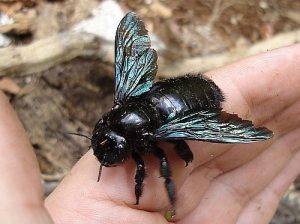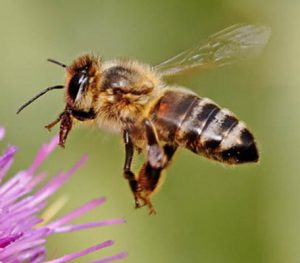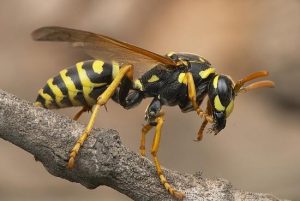Bees
 Carpenter bees build nests in wood, creating galleries that can weaken structures; however, they rarely cause severe damage. People may be frightened by carpenter bees because of their large size, their similarity to bumble bees, and their annoying noise.
Carpenter bees build nests in wood, creating galleries that can weaken structures; however, they rarely cause severe damage. People may be frightened by carpenter bees because of their large size, their similarity to bumble bees, and their annoying noise.
Identification
Most carpenter bees, are large and robust insects resembling bumble bees. They are usually about 1 inch long and colored a metallic blue-black with green or purplish reflections. They differ from bumble bees in that there is shiny with fringes of hairs on some segments. Males of some species are lighter colored, ranging into golden or buff hues.
Carpenter bees cause damage to wooden structures by boring into timbers and siding to prepare nests. The nests weaken structural wood and leave unsightly holes and stains on building surfaces. Sound, un-decayed wood without paint or bark is usually selected for nests. Carpenter bees also frequently attack dead wood on trees or lumber from southern yellow pine, white pine, California redwood, cedar, Douglas fir, cypress, mimosa, mulberry, ash, and pecan trees. They avoid most hard woods. The presence of carpenter bees around buildings and wooden structures can be annoying or even frightening; however, males cannot sting and females rarely attack.
Stinging Bees
 Nearly everyone has been stung by an insect at one time or another. It is an unpleasant experience that people hope not to repeat, but for most people the damage inflicted is only temporary pain. Only a very limited portion of the population (about two people out of 1,000) is allergic or hypersensitive to bee or wasp stings.
Nearly everyone has been stung by an insect at one time or another. It is an unpleasant experience that people hope not to repeat, but for most people the damage inflicted is only temporary pain. Only a very limited portion of the population (about two people out of 1,000) is allergic or hypersensitive to bee or wasp stings.
Stinging insects are limited to the order Hymenoptera, which includes wasps, bees, and ants. The stinger is a modified egg-laying apparatus, so only females can sting. Most hymenopterans live solitary lives and their behavior is more likely to be flight than fight. Social hymenopterans, including yellow jackets, honey bees, bumble bees, and fire ants, have individuals in the colony whose task it is to defend the nest. If the nest is disturbed, these individuals will defend it vigorously. In addition, foraging members of the colony will also sting if they are disturbed or injured as they go about their activities. Some, such as the yellow jacket, are much more liable to attack than others.
The Africanized honey bee is closely related to the European honey bee, which is used in agriculture for crop pollination and honey production. The two types of bees look the same and their behavior is similar in many respects. Neither is likely to sting when gathering nectar and pollen from flowers, but both will sting in defense if provoked.
An individual Africanized bee can sting only once and has the same venom as the European honey bee. However, Africanized honey bees are less predictable and more defensive than European honey bees. They are more likely to defend a greater area around their nest, and they respond faster and in greater numbers than the European honey bee.
Wasps
Only a few of the very large number of wasp species in California live a social life; these species are referred to as social wasps. Some social wasps are predators for most or all of the year and provide a great benefit by killing large numbers of plant-feeding insects and nuisance flies; others are exclusively scavengers. Wasps become a problem only when they threaten to sting humans. One of the most troublesome of the social wasps is the yellowjacket.
Identification
In western states there are two distinct types of social wasps: yellowjackets and paper wasps. Yellowjackets are by far the most troublesome group. Paper wasps are much less defensive and rarely sting humans. They tend to shy away from human activity except when their nests are located near doors, windows, or other high traffic areas.
Nests of both yellowjacket and paper wasps typically are begun in spring by a single queen who overwinters and becomes active when the weather warms. She emerges in late winter/early spring to feed and start a new nest. From spring to midsummer nests are in the growth phase, and the larvae require large amounts of protein. Workers forage mainly for protein at this time (usually in the form of other insects) and for some sugars. By late summer, however, the colonies grow more slowly or cease growth and require large amounts of sugar to maintain the queen and workers. So foraging wasps are particularly interested in sweet things at this time.
Normally, yellowjacket and paper wasp colonies only live one season. In very mild winters or in coastal California south of San Francisco, however, some yellowjacket colonies survive for several years and become quite large.
Yellowjackets
 The term yellowjacket refers to a number of different species of wasps. Included in this group of ground-nesting species are the western yellowjacket, which is the most commonly encountered species and is sometimes called the “meat bee,” and seven other species are common in rotted tree stumps at higher elevations (the German yellowjacket) is becoming more common in many urban areas of California, where it frequently nests in houses. These wasps tend to be medium sized and black with jagged bands of bright yellow (or white in the case of the aerial-nesting) on the abdomen, and have a very short, narrow waist (the area where the thorax attaches to the abdomen).
The term yellowjacket refers to a number of different species of wasps. Included in this group of ground-nesting species are the western yellowjacket, which is the most commonly encountered species and is sometimes called the “meat bee,” and seven other species are common in rotted tree stumps at higher elevations (the German yellowjacket) is becoming more common in many urban areas of California, where it frequently nests in houses. These wasps tend to be medium sized and black with jagged bands of bright yellow (or white in the case of the aerial-nesting) on the abdomen, and have a very short, narrow waist (the area where the thorax attaches to the abdomen).
Paper Wasps
Paper wasps are large (1-inch long), slender wasps with long legs and a distinct, slender waist. Background colors vary, but most western species tend to be golden brown, or darker, with large patches of yellow or red. Preferring to live in or near orchards or vineyards, they hang their paper nests in protected areas, such as under eaves, in attics, or under tree branches or vines. Each nest hangs like an open umbrella from a pedicel (stalk) and has open cells that can be seen from beneath the nest. White, legless, grublike larvae sometimes can be seen from below. Paper wasp nests rarely exceed the size of an outstretched hand and populations vary between 15 to 200 individuals. Most species are relatively unaggressive, but they can be a problem when they nest over doorways or in other areas of human activity, such as fruit trees.
Mud Daubers
Mud daubers are black and yellow, thread-waisted, solitary wasps that build a hard mud nest, usually on ceilings and walls, attended by a single female wasp. They belong to the family Sphecidae and are not social wasps but may be confused with them. They do not defend their nests and rarely sting. During winter, you can safely remove the nests without spraying.

